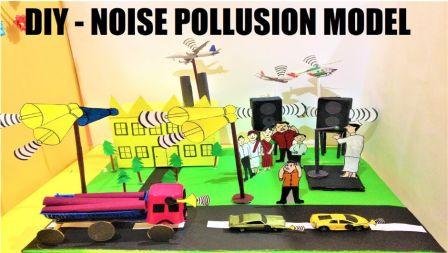A Noise Pollution Model visually demonstrates how excessive noise from various sources impacts the environment, health, and overall well-being. It serves to raise awareness about the importance of managing noise pollution in urban and industrial areas. Here’s a basic explanation of how this model works and its purpose:

Concept of the Noise Pollution Model
The model is designed to show how noise pollution is generated by human activities, particularly in urban environments. It visually represents common sources of noise pollution, such as traffic, industrial machinery, and construction, and highlights their negative effects on people, animals, and the environment.
How It Works
- Sources of Noise Pollution:
- Traffic: A section of the model represents roads or highways with miniature cars, buses, and trucks to showcase the noise created by vehicles. The constant sound from honking, engine noise, and tire friction on roads adds to urban noise levels.
- Industrial Activities: Factories and machines in the model simulate the noise pollution caused by manufacturing and construction processes. Heavy machinery, generators, and air compressors contribute to the overall noise levels.
- Airports and Railways: Another part of the model can represent an airport or railway station, where aircraft and trains produce high-decibel sounds.
- Effects on Health and Environment:
- The model uses figurines of people, animals, and plants placed in various areas to show how noise pollution affects health. For example, people near the roads or factories may experience stress, hearing loss, and sleep disturbances.
- Animals in natural habitats may also be affected by loud noises that disrupt communication, navigation, and breeding.
- Sound Waves Representation:
- Sound Waves: Colored lines or arrows (like strings or paper) can be used to represent sound waves traveling from noise sources to different areas. This demonstrates how far the noise travels and its widespread impact on surrounding areas.
- Health Effects: Near human figures, there could be labels showing the effects of noise pollution, such as “stress,” “hearing impairment,” and “sleep disorders.”
Solutions to Noise Pollution
- Sound Barriers:
- The model can demonstrate solutions like constructing sound barriers (using foam sheets or cardboard walls) to reduce the spread of noise in certain areas.
- Green Spaces:
- Adding trees, bushes, or other greenery to parts of the model illustrates how vegetation can help absorb and block out noise, promoting quieter environments.
- Noise Regulations:
- The model can include labels that explain the importance of government regulations to control noise levels, such as restrictions on vehicle noise, factory work hours, and airport operations.
Conclusion
The Noise Pollution Model serves as an educational tool to showcase how various human activities contribute to noise pollution and its harmful effects on health, wildlife, and the environment. It also highlights potential solutions, such as soundproofing and green spaces, that can mitigate noise pollution and create healthier, quieter environments.

